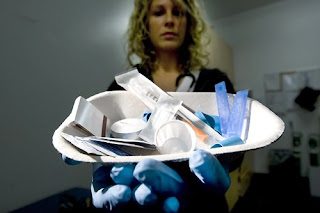More on Harm Seduction
See also Robert's post on his blog re: Harm Seduction.
Slowly the army of informed and reasonable and truly caring people are speaking up about the NEED FOR TREATMENT.
Join the groundswell. Speak out.
"WITHOUT PUBLIC DISCOURSE, DEMOCRACY IS BUT A WHISPER" David Berner
See also Robert's post on his blog re: Harm Seduction.
Slowly the army of informed and reasonable and truly caring people are speaking up about the NEED FOR TREATMENT.
Join the groundswell. Speak out.
Posted by
David Berner
at
7:04 PM
3
comments
![]()

The Basi Virk trial is one of the greatest shams and miscarriages of justice this sorry jurisdiction has ever witnessed.
Now, to add to the injury, the BC government wants to ban the publication of 90 e-mails that have some relevance to the proceedings.
Does Wally Opaque have his sticky hand in this obscenity?
Whoever is involved might be reminded of the old adage that, "not only does justice need to be done, it needs to be seen to be done."
Transparency has not been a long suit for the BC Liberals.
Posted by
David Berner
at
9:22 AM
3
comments
![]()
The photo shown below with the Margaret Wente piece is of Bethany Jeal, a nurse with the Downtown East Side Clinical Housing Team, whatever that is.
I believe that the sickest person in the DTES is this young woman and her colleagues.
They are so sincere, so caring, so sure that they are helping.
Let's be very, very clear.
I spent 10 years of my life working with addicts.
Not only would it never have occurred to me to don rubber gloves and hand out killing machines, we never even for one second discussed drugs!
We talked a lot.
We talked about sadness, anger, disappointment, work, accomplishment, love, friendship, parents, children, art, music, sport, food, LIFE.
Result? Literally hundreds and hundreds of clean and sober non-using former addicts.
When I see the likes of Bethany, I don't know if I want to cry or grab an axe.
Posted by
David Berner
at
9:16 AM
2
comments
![]()

Sergeant Mark Steinkampf knows every back alley in Vancouver's Downtown Eastside. He greets the regulars by name and doesn't miss much. On street patrol one balmy evening, he spots a new face – a young, attractive woman on a bicycle. He motions her to stop.
“I can see that crack pipe in your bra there,” he says. He pulls it out and dangles it in the air. “You're under arrest. Let me read you your rights.” He drops the crack pipe and crushes it beneath his shoe.
The woman doesn't have drugs on her. If she's smart, she'll get out of here fast and he'll never see her again. If she's not, her prospects aren't good. A year from now, she'll likely be ravaged by drugs and infections, turning tricks to get the money for a fix. If she's very unlucky, she'll wind up like another girl, whose body was found by a dumpster, stuffed into a plastic bag like so much garbage.
Vancouver is famous for its innovative approaches to drug treatment. Twenty years ago, it launched a bold experiment to tackle the problems of the notorious Downtown Eastside. The guiding idea was harm reduction. If you couldn't cut off the drug supply or jail all the addicts, then at least you could reduce the secondary damage – HIV, hepatitis and the like – by giving people clean needles. You would surround them with medical and social services. Addiction, all agreed, was an illness, and addicts deserved compassion and respect. Bethany Jeal a nurse with the Downtown East Side Clinical Housing Team, holds a typical tray with an injection kit that will be handed out to drug users at Insite.
Vancouver's needle exchange, the first in North America, opened in 1989. That first year, about 128,000 needles were handed out. Today, the streets are flooded with more than three million free needles each year. The sick and malnourished, many of them with open sores, freely inject drugs. Between 5,000 and 10,000 addicts live within these eight square blocks. The HIV rate hovers around 40 per cent; hepatitis-C rate is 85 per cent. There are more than 150 social services located in the area, offering everything from counselling and shelter to free lunch and art supplies. But there are virtually no treatment beds.
Mark Steinkampf, who heads the Downtown Eastside detail, has worked this beat for 18 years. He cares about the people, and wants to get a message out: Harm reduction – the philosophy that has come to dominate drug policy – doesn't work. Just the opposite. It digs the pit of addiction deeper and wider.
Insite is the supervised-injection facility that has come to symbolize harm reduction. Here, addicts can shoot up in a clean, well-lit booth under the eye of helpful nurses, who supply them with clean needles and treat them if they overdose. Its supporters say Insite is a remarkable success story that reduces infections and saves lives. But Sgt. Steinkampf just laughs. “It's like saying, ‘Hey man, you're really high. Want some treatment? Here's some more drugs!' ”
Advocates say the Insite experiment (now in its sixth year) is a progressive, compassionate approach that is supported by almost everyone. As they tell it, the only opposition comes from a few rogue cops, hard-line abstinence types and right-wing ideologues.
In fact, that is not the case. Many front-line workers, including addictions doctors, nurses and people who run successful rehab programs, believe the philosophy Insite represents has been a disaster. Some are hesitant to speak out, because harm reduction is official policy and criticizing it can be a career-killer. Others think it's time people heard their side.
“We here treating addicts see a very different world,” says Stan de Vlaming, an addictions doctor who's work-ed with the Downtown Eastside population for a dozen years. His patients are the most entrenched and addicted of all. As he sees it, they don't need more free lunch. They need entry-level recovery houses – preferably far away from here – where they can be closely supervised for months.
They also need a far more aggressive push into treatment and recovery – something they don't get from the many, many helpers who are busy finding them housing and giving them free needles. “Harm reduction without a treatment component is a failed policy,” he says.
Today, rehabilitation is the treatment of last, not first resort. “Rehabilitation” and “recovery” are terms you don't hear from advocates of harm reduction. What you do hear, over and over again, is the word “safe” – a word that many addictions doctors take issue with.
“I saw a patient the other day who's still injecting two or three times a week,” says Dr. de Vlaming. “I explained that there's no safe way of injecting drugs. He said, ‘No one's ever told me that.' ”
“Safe injection is a misnomer,” says Milan Khara, another veteran addictions doctor. “Insite is a supervised injection site. Injections inevitably lead to medical complications.”
St. Paul's Hospital is the big red-brick building where they deal with the complications. It treats addicts with life-threatening infections of the heart, brain and bone. “When you put a needle into your arm, the infection can land anywhere,” Dr. Khara explains. Bringing the infection under control with antibiotics takes weeks or months.
Despite the supervised-injection site, the number of addicts with such complications has steadily increased. Today, they make up 10 per cent of the patient population at St. Paul's, and account for nearly 20,000 hospital days a year. “Insite did not have any effect on these serious infectious complications,” says Dr. de Vlaming.
One such patient, a 32-year-old woman with a heart infection, has been hospitalized repeatedly. This time, she knows she'll die if she can't get a treatment bed. But those are scarce. This month, the government finally opened a long-awaited recovery facility in nearby Burnaby. It's a drop in the bucket.
“I've lived down here for the best part of a decade and it's been getting crazier every day,” says Dr. Khara. “I don't see any return on our investment.” An increasing number of ordinary citizens agree. “For the life of me, having lived in that 'hood, I see no evidence of any ‘harm' being ‘reduced,' ” wrote Ruth Meta in a letter to The Vancouver Courier.
Back on the beat, Sgt. Steinkampf tries to reassure a frantic mother who's searching for her son. “Look around!” he says afterward, gesturing at the dishevelled men with their shopping carts and the ravaged women who look 60, but are 30. “And they're calling this fucking mess a success? Anyone can see it has failed utterly.”
The police – and many others – argue that well-intentioned but misguided social policies have turned this place into a vast enabling industry. Contrary to popular belief, the police have no desire to throw addicts in jail. They want to help them kick the habit and escape.
They want more drug-court diversion programs, and they want treatment to be made a part of sentencing. They're sick of watching people die.
Ten years ago, some of the police, including Sgt. Steinkampf, began documenting this world on videotape. They wanted to put a human face on the statistics. They called themselves the Odd Squad, and invested thousands of hours of their own time to bring their stories to the world. Their latest film, Tears for April, should bring shame to policy-makers. It chronicles the struggles of several addicts – including a girl named April, whom they followed from the time she first arrived on the street as a pretty teenager. It was she who was found murdered, stuffed into a plastic bag by the dumpster.
Posted by
David Berner
at
9:07 AM
5
comments
![]()
